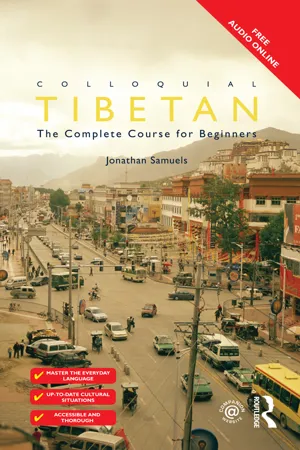
- 336 pages
- English
- ePUB (mobile friendly)
- Available on iOS & Android
About this book
Colloquial Tibetan provides a step-by-step course in Central Tibetan as it is spoken by native speakers. Combining a thorough treatment of the language as it is used in everyday situations with an accurate written representation of this spoken form, it equips learners with the essential skills needed to communicate confidently and effectively in Tibetan in a broad range of situations. No prior knowledge of the language is required.
Key features include:
- progressive coverage of speaking, listening, reading and writing skills
- phonetic transliteration of the Tibetan script throughout the course to aid pronunciation and understanding of the writing system
- structured, jargon-free explanations of grammar
- an extensive range of focused and stimulating exercises
- realistic and entertaining dialogues covering a broad variety of scenarios
- useful vocabulary lists throughout the text
- additional resources available at the back of the book, including a full answer key, a grammar section, bilingual glossaries and English translations of dialogues.
Balanced, comprehensive and rewarding, Colloquial Tibetan will be an indispensable resource both for independent learners and for students taking courses in Tibetan.
Audio material to accompany the course is available to download free in MP3 format from www.routledge.com/cw/colloquials. Recorded by native speakers, the audio material features the dialogues and texts from the book and will help develop your listening and pronunciation skills.
By the end of this course, you will be at Level B2 of the Common European Framework for Languages and at the Intermediate-High on the ACTFL proficiency scales.
Frequently asked questions
- Essential is ideal for learners and professionals who enjoy exploring a wide range of subjects. Access the Essential Library with 800,000+ trusted titles and best-sellers across business, personal growth, and the humanities. Includes unlimited reading time and Standard Read Aloud voice.
- Complete: Perfect for advanced learners and researchers needing full, unrestricted access. Unlock 1.4M+ books across hundreds of subjects, including academic and specialized titles. The Complete Plan also includes advanced features like Premium Read Aloud and Research Assistant.
Please note we cannot support devices running on iOS 13 and Android 7 or earlier. Learn more about using the app.
Information
Syllables, letter combinations and words



| 1 ming | 4 shikatse | 7 yaya |
| 2 khyi | 5 lame | 8 ṭhaṭik |
| 3 eni | 6 phökä |

Table of contents
- Cover
- Half Title
- Title Page
- Copyright Page
- Table of Contents
- Acknowledgements
- Introduction
- Pronunciation and the alphabet: basic sounds and symbols
- 1 Syllables, letter combinations and words
- 2 tāshi-tele'. tepo yin-pä Hello. Are you well?
- 3 Khyērang khanä yin Where are you from?
- 4 tāshi khawa: tu' Where is Tashi?
- 5 tonkhang-la yo'-pa At the guesthouse
- 6 ka mi-ka Likes and dislikes
- 7 chakhang-la kacha cītömoltö' shapa Banter at the teahouse
- 8 chūtshö' khatsho'-la At what time? (Making arrangements)
- 9 khālak thang sakhang-ki kōr Food and restaurants
- 10 nyopcha-kyapa Shopping
- 11 tepo min-tu'-kä Aren't you well?
- 12 tulkyö'-ki kōr Travel
- 13 khare-sa What did he say?
- 14 khushap thōk Respectfully
- 15 chōk shanthak-nä ta'-na ... From another perspective ...
- Grammar section
- Key to exercises
- Translations of dialogues (Units 8–15)
- Tibetan–English glossary
- English–Tibetan glossary
- Index